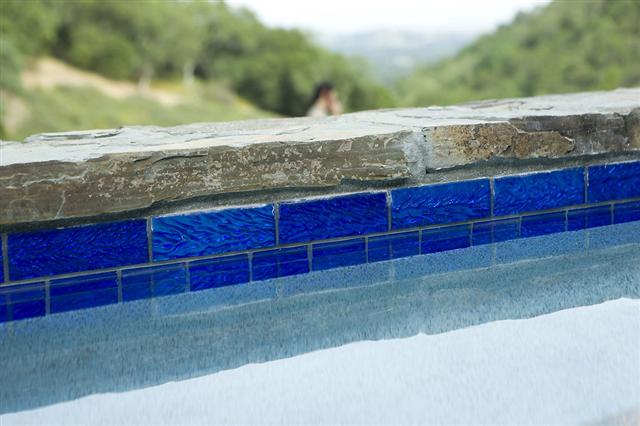Blog
How Are Ceramic Swimming Pool Tiles Made?

Ceramic swimming pool tile starts life as a lump of earth — everything in that final product is a natural material. Each manufacturer likely has its own time-tested recipe for ceramic pool tile, but clay is usually the main ingredient, along with other items such as sand, feldspar, quartz and water. These ingredients are mixed and grounded up in a ball mill to create what’s known as the body slip. Body slip is used to differentiate the body of the tile from its glazed topping; it’s the chocolate cake to vanilla frosting. At this point, the body slip contains about 30 percent water. That moisture helps adhere the ingredients to each other, but as soon as its job is done, it’s out of there. To accomplish this, the body slip is put into a dryer and heated; the moisture content is reduced to about 6 percent. Â After that time in the dryer, the body slip is now essentially powder, or dust. This entire process is sometimes called dust pressing — and you’re about to learn why. The dust is placed into a large press, powered either with electricity or hydraulics. The press pushes the dust into a set size and shape with a force ranging from a few hundred pounds a square inch to 100,000 pounds per square inch (689,475.7 Newtons per square meter) [source: Bedrosians]. That pressure is what gives the finished project its tensile strength. While we commonly see square or rectangular ceramic tile, presses may have shaped imprints to create ovals, diamonds and other unique shapes as well. The shaped body is called the bisque. After the body is formed, it’s dried out to remove all last traces of moisture.
Now it’s time for that frosting we mentioned — the glaze. The word comes from the Old English word for glass, which is a good description of glaze. It’s that glassy looking substance on one side of the tile. Just as there’s a wide variety of delicious frostings, there are many choices for the glaze, including matte and high-gloss, and many ways of applying glaze, from spray to silkscreen. To give the pool tile some color, pigments are mixed in with the other ingredients. However, even if very vibrant pigments are used, the piece will still look fairly pale, and not like the vibrant tiles we see in the store. That process won’t happen until the next step. Though glazing is a typical step for ceramic pool tile, it’s not essential. Not every tile has to be glazed to be considered ceramic.
But there is one qualification that ceramic pool tiles do have to meet — they all have to be baked. Before it goes in the kiln, the product has acquired another name: green tile
After the glaze has been applied, it’s time to put the swimming pool tiles in the kiln to be fired. Traditionally, ceramic pool tile was left to bake for several hours in what’s known as a periodic kiln, such as a beehive kiln. It was the continuous kiln, however, that made the production process of ceramic tile more efficient in the last century. Continuous kilns include tunnel kilns and roller-hearth kilns. If you’ve ever been to a sandwich shop where the worker heats the sandwich by giving it a ride through the toaster, then you’ll understand these new types of kilns. Rather than sitting in the heat for hours, the pool tile is rolled through by conveyor belt-type contraptions (the specific apparatus varies from kiln to kiln). The heat inside the kiln is precisely monitored and controlled by computer. In the first half of the tile’s journey, things are starting to get warm. At the center point, maximum temperature, which can be as high as 2,500 degrees Fahrenheit (1,371.1 degrees Celsius), is reached. The higher the temperature, the stronger the brick. As the pool tile makes its way to the opposite side of the tube, it’s gradually cooling down. The cooling down period isn’t as passive as it might sound, though — pool tiles are still changing color. With these rolling, or continuous kilns, the process has gone from hours of stationary baking to less than an hour. That allows the manufacturers to make a lot more tile, at a reasonable price for the marketplace. The process was also expedited by the resurgence of the monocottura method. Monocottura, an Italian term meaning “fired once,” gives ceramic swimming pool tile a lot more strength. This additional strength is what allowed pool tile to go from a product best suited for walls to one that is also good for floors and swimmong pools. After just one trip through a hot kiln, the tile made with the monocottura method is ready to be sorted and sent off to the store. Â If firing a pool tile just once makes it so much stronger, why bother with any more firings? If you want a tile with many colors or an elaborate pattern, then that tile will be baked with a bicottura method. Though the prefix would indicate that the pool tile is fired twice, it can actually be fired as many times as necessary. Before each firing, a different colored glaze is applied to the swimming pool tile, and the process is repeated until the design is complete.
At this point, our superheroic ceramic pool tile has gone from clay to dust to tile. Ceramic swimming pool tile may require many more costume changes than Wonder Woman, but it can also go a lot more places in your home than she can. (howstuffworks.com)
